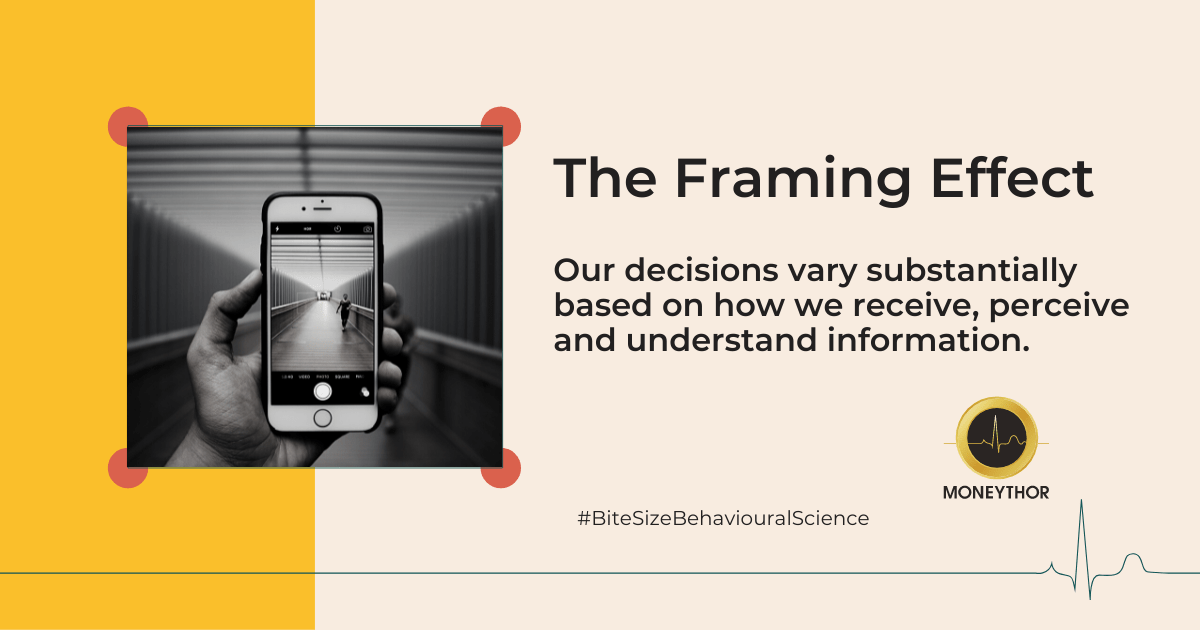Our decisions vary substantially based on how we receive, perceive and understand information. The same key details can be effectively redescribed in various ways, thus influencing the way they are understood, and the decisions made as a result.
What is the Framing Effect?
The framing effect is a cognitive bias which describes how identical scenarios, when portrayed in different ways can result in vastly different choices and decisions being made. Human behaviours and responses to the same situation can be influenced significantly by the context in which the inherent ideas are framed – through questions asked, choice in use of language and presentation of information.
For example, a consumer is looking to buy some diet cola over in the supermarket. One was marketed as “80 percent sugar free” and the other says it contains “20 percent sugar.” The framing of nutritional information resulted in the former being chosen, because it appears to be the healthier option despite the fact that there is the same amount of sugar in both drinks. The higher value highlighted in the first diet cola was associated with it being the better option. This is but one example of how identical information can be perceived as less or more enticing depending on what attributes are accentuated, and there are plenty of those when it comes to our finances.
Why does it happen?
Our brains attempt to simplify decision making processes by using cognitive shortcuts to quickly establish outcomes in our daily lives. Decisions associated to the framing effect are based upon the way information is introduced to us, rather than the information itself. As such those decisions may be ill-informed – lesser options can be portrayed positively and can make them seem more favourable than they actually are.
When it comes to framing, Tversky et al (PDF) puts forward that “outcomes are commonly perceived as positive or negative in relation to a reference outcome that is judged neutral.” The framing effect is not just about how information is portrayed, it is also based on benchmarking and outward reference points. Alternative reference points can consequently also affect whether an outcome is determined to be advantageous or disadvantageous.
Additionally, people are generally loss averse and want to steer clear the negative emotions being evoked as a result of losses as much as possible. Framing an outcome around a loss has been shown to have more impactful and longer lasting effects than the same outcome presented as a gain.
How can banks address the framing effect and help their customers avoid this cognitive bias?
Quizzes, surveys and questionnaires
In order to help consumers understand their financial situations better, quizzes, surveys and questionnaires can be employed within digital banking apps. This method of self-discovery can help users realise not just what their financial goals are, but more importantly what their risk appetites are financially, thus helping them gain clarity of what financial decisions they can afford to make, regardless of how the framing effect can make them feel about potential purchases and investments.
Personal Financial Management (PFM) solutions
With the deployment of PFM solutions for banks, rich, interactive and educative perspectives on their finances can be given to consumers to enhance the framing of their financial data. PFM features can surface options in a manner that highlights positives (or downsides) of the financial decisions being made, thus allowing users to fully understand the impact of the past and future decisions they are making. Positive language and the appropriate tone of voice can also be used to frame information and help encourage users to save for the future.
Framing saving as a default choice in digital banking services
A key aspect of consumer behaviour indicates that consumers are more likely to stick with the easiest option that has been presented to them. By presenting users with a default choice of saving or setting up smart automated transfers into their savings accounts, financial institutions are framing savings as a key aspect, thus making it less likely that consumers will opt-out from the automatic default framework of saving.
Conclusion
As consumers, the framing effect has the potential to impact both positively or negatively. In order to avoid it, it is key to remember the most important thing to focus on is the message rather than the method of delivery. As financial institutions, it is possible to use the framing effect as a means to nudge customers into making better financial decisions. Effectively framing the right messaging can help users act in a way that will benefit their financial wellbeing in the long run.

